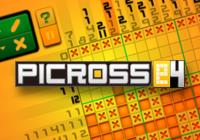Picross e4 (Nintendo 3DS) Review
By Rudy Lavaux  11.02.2016
11.02.2016

Puzzle games have never been quite as addictive or as successful as when they were released on portable systems. Ever since the Game Boy's Tetris in 1989, the genre gradually established itself as handheld-centric, with important, successful releases in the genre being mostly released on systems that could be enjoyed on the go. Picross is one such series, which, despite the concept itself of nonogram puzzles finding its roots in printed publications, found its first success on with Mario's Picross. The concept has never felt quite as good as it did on the DS in 2007, though, introducing touch screen controls that make perfect sense to pinpoint which squares to break or mark. The advent of digital distribution has meant that puzzle games with a concept as simple and addictive as that of Picross can now be distributed at a price point much more fitting and more likely to attract as many potential customers as possible. This is what developer Jupiter did when it released the first few titles in the Picross e sub-series. Released in 2014, Cubed3 takes a look back at Picross e4.
Fans of Picross likely won't need any sort of introduction to the concept of nonogram puzzles, but newcomers definitely will. Each puzzle is presented as a grid of a certain number of squares. The goal is to break down the correct square tiles so that they form a target shape, representing a pixelated object or subject. To figure out which tiles must be broken, hints are laid out around the puzzle field in the form of digits, indicating how many groups of pixels are in the row or column, and how many pixels are in each group. Groups can be positioned anywhere in the row or column, but they are positioned in the same order given by the hint, so it's up to the player to use all the information at their disposal to figure out which tiles are the right ones. Breaking all of the right ones, in the case of recent Picross titles, reveals a colour version of the same image, and if what it represents in such low resolution isn't obvious, a caption is unveiled, as well, informing of what it does represent.

This has been the core concept of nonogram puzzles in video game form since the release of Mario's Picross for the Game Boy. What the video games have brought, though, are, as one would expect, automation of certain mechanics. Picross puzzles have a time limit of 60 minutes, after which the game is lost and must be started over.
Additionally, breaking down the wrong tiles will induce a penalty of two minutes, then four at the second mistake, and then eight for each subsequent mistake, so it's impossible to win by simply breaking tiles at random. Therefore, it is primordial to make good use of the marking mechanic, which puts a cross on a tile, instead of breaking it, so as to not break those and score a good time. Every version of Picross keeps track of the time it took to solve every puzzle available, so the game also offers a personal challenge to solve every puzzle fast. Originally, they came only in sizes of 15x15 squares. However, since the DS title, they can also come in smaller sizes, as well as larger ones up to 20x15 squares, which increases the difficulty considerably.

Also introduced in recently-released titles is the ability to mark certain rows or column hint digits in blue, which means that, using pure logic and some of the several techniques in nonogram puzzles to figure out where the right tiles are, the player should be able to mark either break or "not to be broken" certain tiles in those lit up lines, which helps a great deal when a particularly tough puzzle is tackled where it's hard to know where to start. Not all puzzles in Picross e4 allow this function to be used, however. Furthermore, some extra help can be requested at the start of a puzzle, as was the case in Mario's Picross, to automatically give away one solved row and one solved column.
If a puzzle is completed using that extra help, however, record will be kept that this function was used. The more hardcore Picross players will naturally want to keep their save file clean of any sort of use of that function. This is the concept of Picross in a nutshell. Since the concept itself remains very much the same with each entry, though, the only difference one would expect from yet another entry in the series lies in the new puzzles, which would then make this new game more of an expansion than its own product. This is not far from the truth, as e4 doesn't introduce any new type of puzzles, like the two previous entries did. Rather, it brings them both back into play, for users' pleasure. These new types of puzzles play with slightly remixed rules. Picross e2 introduced Micross, which has brought back here for another spin. A Micross puzzle starts off with one 10x10 easy Picross puzzle, which, once completed, reveals a very crude image that does not represent anything particular. This image turns into some sort of map where each of the 10x10 squares becomes another Picross puzzle. Solving those will add finer detail to the overall crude image, the Micross, and once each has been completed, the global subject is unveiled, which, in the case of Picross e4, can be a world famous piece of classic art to add some classy flair to the challenge.

Naturally, since each square is part of an overall image, detail unveiled in one of the smaller Picross puzzles can help in giving some hints about what will be found in the adjacent squares, which serves as a good way to shake up a little bit how puzzles are approached. The other type of puzzle, introduced in Picross e3, is called Mega Picross. It plays very much the same as a standard Picross puzzle, where each one is its own independent puzzle, but with one big difference. This time, certain hint digits cover two rows or columns at a time, adding some extra difficulty to the puzzle. Those digits indicate pixels glued together in any shape or form, that cover those two rows or columns, surrounded by empty spaces, as well, just like regular groups. These puzzles are to be approached with a different logic.
The keen eye will recognise easily in these types of puzzles elements that were brought back in the recently-released free-to-play Pokémon Picross, also made by Jupiter. This title plays exactly the same; just without the Pokémon theme attached to it and all the special powers that Pokémon bring to the table to help clear puzzles. Last but not least, the detected presence of save files from any or all of the three previous entries in the series for the 3DS eShop will unlock a few extra Picross puzzles as a bonus to reward the patronage, which is a nice and welcome addition.

Cubed3 Rating
Very Good - Bronze Award

Picross e4 doesn't bring anything new to the table and feels like an expansion, rather than a fully new package. Everything from the plain, yet clean, presentation to the type of content is recycled from previous instalments, only bringing new puzzles to solve. However, one has to remember the addictive nature of the concept itself and Picross e4 can just as well serve as a good entry point to the concept, or as a solution to anyone's Picross cravings, because everything it does it does it well. The controls are spot on - make sure that touch screen is well calibrated, though - and the music and sound effects, while nice, fit the theme well and aren't be a distraction. Jupiter has proven itself over the years as the sole developer of Picross games for Nintendo hardware, so this does not come as a surprise. Fans and newcomers alike are in the clear with this title and if anyone unfamiliar with the series is unsure about this whole Picross business, the free-to-play Pokémon Picross by the same developer is up on the 3DS eShop to sample it at no charge!
Comments
Comments are currently disabled

 Sign In
Sign In Game Details
Game Details
 Out now
Out now  Out now
Out now  Out now
Out now  Out now
Out now  Subscribe to this topic
Subscribe to this topic Features
Features





 Top
Top

